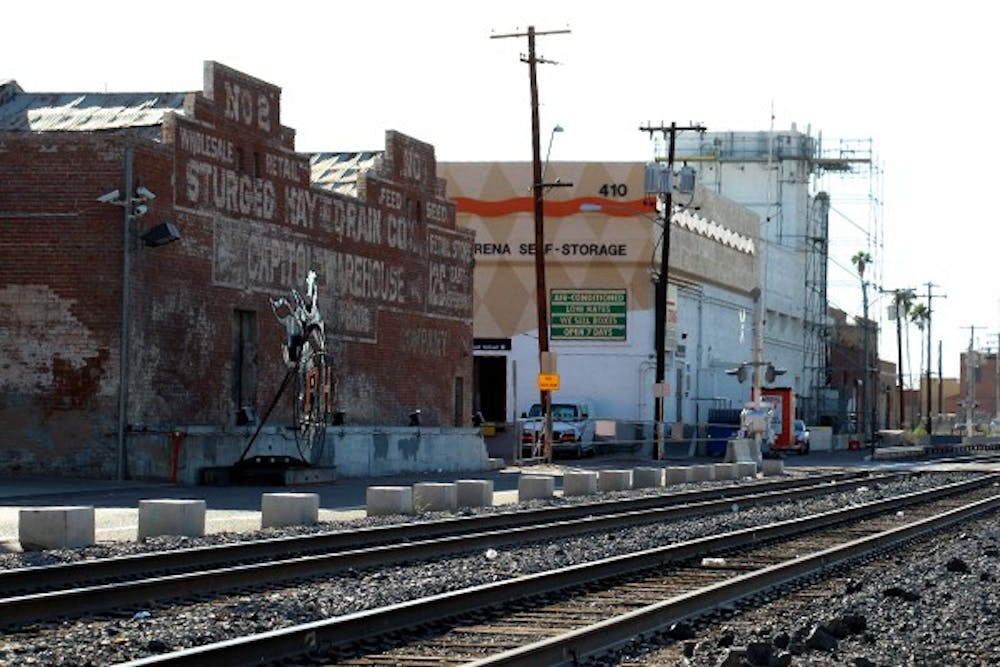 A collection of businesses, city officials and ASU students are working to improve Downtown Phoenix's well-known Warehouse District. (Photo by Tynin Fries)
A collection of businesses, city officials and ASU students are working to improve Downtown Phoenix's well-known Warehouse District. (Photo by Tynin Fries)The work of an ASU urban design workshop class, which sought to create a plan to reactivate the historic downtown Phoenix Warehouse District, has sparked discussion about the balance between development and preservation in downtown Phoenix.
Community members including building owner Michael Levine said they believe considerable development, which may call for the demolition of some warehouse buildings, could be detrimental to the district.
“You can’t have a Warehouse District without warehouses,” Levine said.
He described himself as a purist in the architecture of the district, which is characterized by old brick warehouse buildings.
Levine said 19.5 percent of the square footage of warehouse buildings in the district is in jeopardy of demolition, in order to create residential areas, sidewalks and bike lanes.
Levine attributes the demolition of 16.5 percent of the square footage to owner Malcolm Marr's property, due to financial issues stemming from taxation and the demolition of an additional 3 percent from Fore Property Company.
If implemented, the reactivation plan will disregard the utilitarian history of the warehouse buildings in favor of modern development and economic growth, Levine said. The Phoenix government was acting as a corporation, not a government, he said.
Eminent domain gives a city’s government the right to take away private property if the government gives the owner payment or compensation and if that property is needed for public use.
Although private property gained an increased protection from eminent domain with the passage of Proposition 207 in 2006, Levine said the government uses property taxes to make it difficult for private business owners to keep their property.
While Levine said he objects to the demolition of buildings in the warehouse district, he also said he believes the reactivation plan is extremely generic and could be applied to any city.
Michelle Dodds, historic preservation officer for Phoenix's Planning and Development Department, said the city has tried without success to make the area into a preservation district in the past.
"We've lost a lot of buildings, so those that remain are kind of precious." Dodds said. "But, I will tell you that with projects that come in, we aren't always able to save every building."
Dodds said she agrees with Levine that residents should do whatever is possible to preserve the building stock that remains.
"But, that's really challenging because not all of the buildings are protected and not all of the property owners are interested in designation," Dodds said.
Yet, the reactivation plan document never explicitly called for the demolition of any buildings in the district, and demolition should most likely be attributed to private owners or outside investment companies, said Lauren Allsopp, faculty associate for the School of Geographical Sciences and Urban Planning.
Allsopp's urban design workshop class spent the 2014 spring semester looking at ways to make the area more efficient and usable, Allsopp said.
"I totally agree with Michael Levine," Allsopp said. "I'd like to save every one."
Because of the city's planned unit development area, which is exempt from historic preservation, and the wishes of private owners, preservation efforts are limited, Allsopp said.
While Allsopp said she supports innovation and growth in the district, saving buildings may not be worth the expense in some cases.
Instead, she said she suggests incorporating the facade of old warehouse buildings that must be demolished into the designs for the buildings that will replace them.
"For the future of these buildings, we need to look at what we put around them," Allsopp said. "It's the overall flavor that's important."
Still, she said economic growth must be considered as well.
"To compete worldwide, we do have to become more aware of our environments and what we can do, but let's do it as a community-based (effort), not (through) outside developments," Allsopp said.
Criminology freshman Valerie Payne said although she is not an expert on the area, she believes that there would have to be a very good reason for the traditionally utilitarian district to incorporate residential areas.
“The business owners that have been (in the Warehouse District) have more insight on what that area needs,” Payne said.
While some community members do not support the reactivation plan, others believe that it may be the best option for development in Phoenix.
Health and wellness freshman Ny-Jalah Rice said she believes the district should adapt to suit the best interest of Phoenix citizens.
“If it is going to be better for everyone in Phoenix, then go for it," Rice said. "If it’s just going to benefit the government, then they shouldn’t (demolish warehouse buildings)."
Reach the reporter at ekamezak@asu.edu or follow her on Twitter @emikamezaki
Like The State Press on Facebook and follow @statepress on Twitter.




